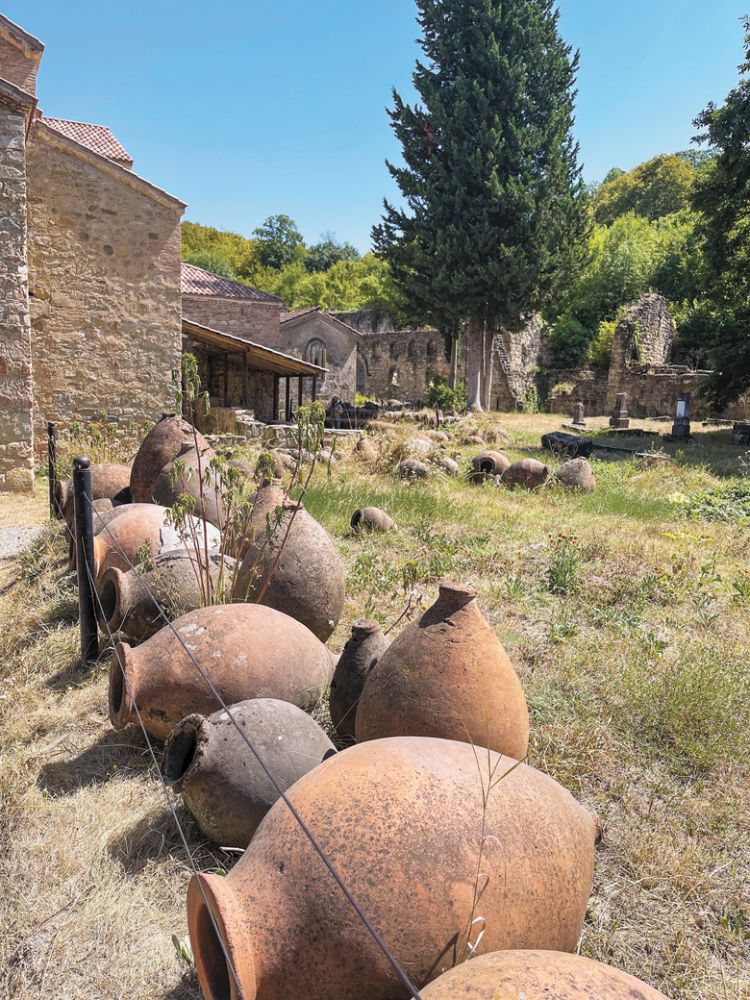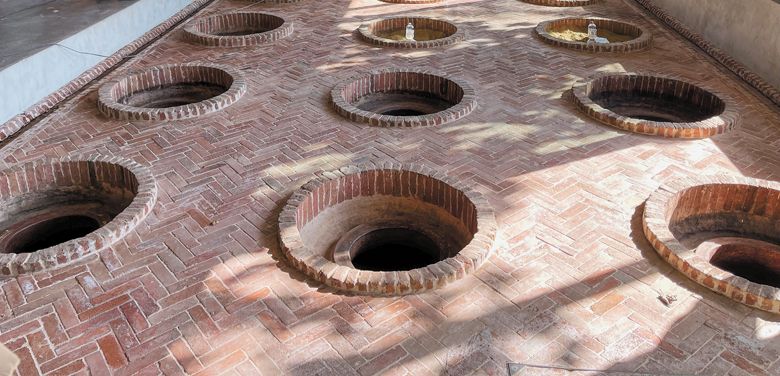Exploring Georgia
The cradle of wine


By Neal D. Hulkower
I like to say, “Join the American Association of Wine Economists, generally abbreviated to AAWE, and see the world.” Since joining in 2012, I have attended annual meetings in Stellenbosch, Mendoza and Padua as well as in the U.S. When the pandemic halted the conference for two years, I jumped at the opportunity to attend the fourteenth AAWE conference in the Republic of Georgia’s capital city, Tbilisi.
I’m certain you’ll agree that a country whose tagline is “8000 Vintages” is an obvious and thirst-inspiring choice. Georgia’s claim to be “The Cradle of Wine” rests on evidence of grape growing and wine production as early as the middle of the sixth millennium BCE. Those interested in possibly too much information should seek out The Wines of Georgia, an authoritative reference written by Lisa Granik MW.
Wine permeates Georgian life, and numerous wine bars and shops punctuate Tbilisi. Many residents in this country of slightly over four million (if you count the Russian-occupied territories, just under 3.7 million if you don’t), maintain personal vineyards and make their own wine, as they have done for centuries.
While there are at least 400 Georgian grape varieties, only a handful are used to make wine. About 75 percent of wine grapes grown are white, with the most common variety Rkatsiteli. The Saperavi grape is the most frequently planted red. International varieties are also planted, including a small amount of Pinot Noir used to make dry and sparkling wine. (Dr. Konstantin Frank Winery in the New York Finger Lakes grows and produces both Rkatsiteli and Saperavi. However, there are no reports of anyone in Oregon experimenting with these or other Georgian varieties.)
Traditionally, wines were made in large earthenware containers called qvevri, also known as churi in Western Georgia. This practice continues today, but modern techniques are also gaining ground. Kakheti, in the far eastern part of the country, is the source of 75 percent of wine grapes and 68 percent of wine.
With war raging on the other side of the Black Sea, instigated by Georgia’s neighbor to the north, coupled with lingering concerns about the pandemic, conference attendance was down. I joined the smaller-than-usual international group of academics, marketing folks and other wine professionals. We enjoyed the welcome reception the first evening, followed by two days of presentations at Tbilisi State University and two more of touring.
Since my wife remained home, my son, Kenny, an oenophile in his own right, chose to tag along. We took a short walk from our hotel to a cozy wine bar and shop “Wine Not?” After we told our host, Ana Berikashivili, we’d like a glass of white and red, she initially offered a taste. It pleased, so we selected it as our white. Since she wanted an honest opinion, only after we approved did she share that it was her wine, a Mtsvane (another popular white variety) made at Berika Winery in Kakheti.
The next day, we visited the closest of four locations of “8000 Vintages,” a much-heralded shop with an overwhelming collection of Georgian wines and racks from floor to ceiling. We were assisted by a young woman who was studying winemaking. We picked up two authentic ice wines for Kenny and sampled Rkatsiteli and Saperavi in advance of a second visit I planned after the conference. When I returned, I let her select some bottles to add to my stash, more about which below.
I chaired the first session on Day Two, providing a summary of an analysis of the results of the 1980 wine tasting that led to the establishment of Domaine Drouhin Oregon. “Contre-degustation Olympiades du Vin According to Borda” compares the rankings of primarily Pinot Noir and Chardonnay by averaging the scores assigned by the judges with those using the more mathematically-justifiable Borda Count. While there were some differences overall, both methods ranked The Eyrie Vineyards 1975 South Block Reserve Pinot Noir second to the 1959 Joseph Drouhin Chambolle-Musigny– which could be considered a ringer due to its age. Regardless, this impressive showing convinced Robert Drouhin, the first Burgundian, to open a Dundee Hills winery in 1987.
A notable AAWE attendee was Robert Joseph, the British wine writer also known as the Devil’s Advocate. Also co-owner of Le Grand Noir wines and editor-at-large at Meininger’s Wine Business International, his main duties seemed to be keeping it real in the face of some very academic and arcane discussions while serving as an advocate for the wine-drinking hoi polloi.
After my presentation, Joseph explained that in Europe, Borda is used to select the best of category in wine competitions, unusual in the U.S. This, of course, led to my enumerating my objections to wine competitions for which I have little regard. As a comparative wine snob and, worse, an opinionated, nerdy analyst, I enjoyed the repartee. Later, he emphasized that all wine-related discussions must be focused on the consumer. Sage advice.
Later that day, I delivered my second presentation, “What Can I Still Afford to Drink?” It considered current availability and pricing for mostly French and German wines I tasted between 1969 and 1979. I recorded bottles sampled in four notebooks. While conducting my research, I also found the prices of more recent vintages that are the same age as those tasted in the 1970s.
To establish the upper limit of affordability, I simply used the price of the most expensive bottle in my collection. I also compared current prices to those inflated using the factors for wine created by the Bureau of Labor Statistics. Since these are intended for commodity wines, they resulted in far lower estimates of prices for the higher-end collectible bottles. This leaves open the question as to whether there might be a method to predict future prices of luxury wines based on an appropriate selection of factors.
To my surprise and delight, my second paper received one of three Christophe Baron prizes for the Best Conference Presentation. Instead of a non-consumable recognition, winners were awarded bottles of Cayuse Vineyards 2018 Armada Vineyard Syrah– much preferred.
One of the many joys of these conferences is the stream of local wines served during breaks, lunches and dinners, simply too many to mention. One memorable bottle appeared toward the end of dinner at the Funicular Restaurant, high above the city. There we were offered a Shalauri Cellars 2016 Saperavi, served from a decanter. Despite being well on my way to satiation, it grabbed my attention. The story of how I ended up with a complimentary bottle involves the persistence of a former freelance journalist from the UK who decided she would repay kindnesses she had received by paying it forward to me. This bottle paired very well with a vegetarian chili.
After the conference ended, we visited Ikalto Monastery and Ikalto Academy. Viticulture and enology were taught there in the twelfth century. We had the opportunity to sample two dozen wines in the village of Tsinandali, then dined and tasted at Mosmieri, a winery founded by German industrialist Joerg Matthies.
We also visited Uplistikhe Cave Town, one of the oldest urban settlements in Georgia. I risked life and limb negotiating steep paths of varying widths and depths trying to maintain a foothold while being buffeted by brisk winds. The reward– close access to the remains of an ancient settlement that included a winery. I’m still debating whether the risk was worth the effort.
Our trip included a stop at Château Mukhrani, founded in 1878 by an heir to the royal family of Georgia. An excellent tour of the impressive facilities ensued, one with both traditional and modern winemaking vessels along with a distillery for making cha cha, the Georgian version of grappa. While I was sampling one of the bold reds, a hallmark of Georgia, a couple approached, enthusiastically asking if I thought it was like a Willamette Valley Pinot Noir. “Not even close,” I insisted.
Before leaving Georgia, I returned to “8000 Vintages” to fill out a case. Many whites are made with extended skin contact, imparting richer color and more tannins, ensuring ageability. I look forward to opening the amber Tchotiashvili Family Vineyards 2017 Rkatsiteli. The most expensive bottle, a Badagoni Wine Company 2015 Saperavi, cost $38.40. Mercifully, the labels are in both English and Georgian. I found it to be an incomprehensible script that looks to this linguistically-challenged observer like a collection of squiggles and artfully arranged picture hooks punctuated with tridents and the universal on/off sign.
Until recently, not much of the wine produced made it to western countries. After the collapse of the Soviet Union, the single largest importer of Georgian wines, the emphasis shifted from quantity to quality. Those seeking something completely different from the international varieties and pervasive winemaking styles would do well to look for bottles from Georgia, or better yet, plan a trip to the country.










